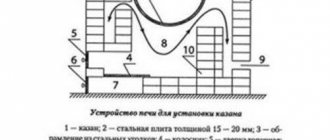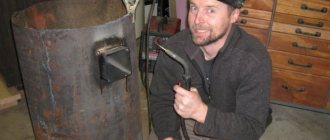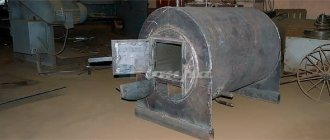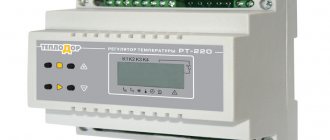The branches left behind after tree trimming are quite an inconvenient waste. Piled up in a heap, they take up a lot of space, and you can’t put the branches into the oven right away; it takes a long time to chop them with an ax. Making a fire and just burning it in the garden is a shame. A suitable option for a thrifty owner is to make a branch chopper with your own hands to process them into wood chips. And there will be a use for it - even burn it in a cauldron, or use it for compost. We are interested in the designs of homemade crushers, since the prices of factory units are not comparable with the volumes of wood processing in an ordinary private sector.
Main components of a garden shredder
To independently assemble a grass and branch chopper (shredder) at home, you must first understand the structure of the mechanism, as well as the principle of its operation. This will help you assemble the equipment correctly and, if necessary, make changes to its design.
A homemade unit, designed for grinding mown grass and sawn branches up to several centimeters thick, has the following main structural components:
- engine;
- knives mounted on the working shaft;
- frame (usually metal);
- protective casing;
- a box designed to receive cut vegetation;
- starting system.
The equipment itself can be made stationary or mobile. To create the latter option, you will additionally need wheels, as well as a handle. To make the frame, use metal corners or ready-made frames from workbenches. Boxes for processed vegetation are made from plastic buckets, tin, and bags. The protective casing around the knives should be thick and durable enough so as not to quickly wear out from the impact of grinding vegetation.
When processing plant debris, crushed pieces may fly out of the opening through which it is fed. Therefore, the neck is covered with a lid or simply with a cloth, for example, a bag.
The operation of the chopper is that rotation from the motor shaft is transmitted directly to the knives or through a chain/belt drive. The vegetation chopped by the blades enters the box. In this case, the final product is immediately ready for use.
According to the principle of operation, some homemade shredders are comparable to a meat grinder (they draw in and then grind organic matter), while others are comparable to a coffee grinder.
Manufacturing Guide
The first thing you need to understand is that without plumbing and welding skills and the appropriate tools, you will not be able to make even a simple branch chopper from circular saws. In addition, for the manufacture of shafts and housings for bearings, you will have to go to a lathe, unless you manage to find a ready-made unit from an old machine. The whole process is divided into the following stages:
- Choosing a shredder design.
- Selection of motor for drive and calculation of main gear.
- Preparation of metal and parts that need to be turned on a lathe.
- Frame assembly.
- Installation of the drive, cutting mechanism and belt drive.
- Installation of the protective casing and hopper.
Note. We are talking about a belt drive as the easiest to manufacture and safest to use. In the event of an accident or overload, the belt will slip or jump off without any consequences. The same cannot be said about a rigid connection through a chain (gearbox).
Design of a disk crusher with removable knives
As for choosing the design of a homemade wood chipper, the recommendations are simple:
- a unit made from circular saws is the best option when you need to get small wood chips at minimal cost;
- if you plan to chop branches of small diameter into a larger fraction, then a cutting mechanism such as a jointer is suitable;
- when you need to chop branches up to 5 cm in size in large quantities, it is better to make a disk crusher.
For reference. Small shavings and wood chips are often used by gardeners to make compost and mulch. You can also make fuel briquettes from it for heating a country house.
Knife shaft and its principle of operation (like a jointer on a circular saw)
When the type of wood chipper is selected, you can begin to prepare parts, materials and equipment. But first of all you need to do...
Selection of engine and calculation of belt drive
Drive power is an indicator that determines how thick a branch you can process on a homemade crusher. Here are some tips for choosing an engine:
- An electric motor with a power of 2.5-3.5 kW, minimum 2 kW, is ideal for your purpose. The 1.5 kW motor can be used to assemble a shredder for grass and small branches.
- The power of a gasoline or diesel engine should be 5-6 liters. With. These are installed on household walk-behind tractors and mini-tractors.
- There is no point in buying an electric motor that is too powerful, unless you have one sitting idle in your shed. It will consume an amount of electricity that does not correspond to the work done.
Note. The number of revolutions of the electric motor does not play a big role, since we will obtain the required rotation speed of the knives due to the V-belt drive.
In order for your wood shredder to reliably chop branches, the blade shaft must be given a speed of no more than 1500 rpm by selecting the diameter of the drive and driven pulleys. The decisive factor here is not the speed of rotation of the knives, but the developed torque (force). The distance between the pulleys and the length of the belt also does not play a big role. Unless a belt that is too long reduces transmission efficiency and is less easy to tension.
Calculation example. There is a 2800 rpm electric motor that needs to be installed on the crusher. The optimal solution is to reduce the shaft speed by half, to 1400 rpm. Then the diameters of the pulleys will differ by 2 times. For example, the size of the driving pulley is 100 mm, then the diameter of the driven pulley (standing on the working shaft) will be 200 mm.
Advice. When ordering pulleys for a V-belt drive from a turner, it doesn’t hurt to think about the future. It is better to make pulleys with 3 or 4 grooves, so that the speed on the working shaft can be changed by rearranging the belt. Then the chopper can be adjusted to different operating conditions, for example, for crushing stalks of corn, sunflowers, and grass.
Pulleys with several grooves are more convenient to use; you can change the rotation speed and force
Preparation of materials
The best way to save money on making wood chippers is to find suitable materials around the house. The following types of rolled metal are suitable for assembling the frame:
- single equal angle corner with a width of 50 to 63 mm;
- 2 corners of 35 mm, welded in a “box”;
- profile pipe measuring 40x40 mm;
- channel No. 6.5—10;
- round pipes with a diameter of 32-48 mm.
The electric motor is mounted on a steel sheet with a thickness of 10 mm and dimensions corresponding to the distance between the mounting holes on its flange (with a margin of 30-50 mm on each side). To tension the belt, 2 types of devices are used:
- The holes in the plate for mounting the engine are made oblong so that it can be moved back and secured with bolts.
- The plate is installed at one end on a hinge, then the belt is tightened due to the weight of the electric motor. On the other hand, it is fixed with nuts on studs, as shown below in the photo of a homemade chopper.
Here the tension occurs under the weight of the electric motor.
To make the simplest shredder design, buy 20-25 circular saws with carbide tips and the same number of spacer washers with a diameter of 20 mm. This will give you a working area of about 80mm wide, which can be made larger or smaller if desired by adding or removing saws.
Note. The thickness of the teeth of a circular saw is greater than the steel base, so it is impossible to fasten the tools close to each other. To compensate for the width of the teeth, washers are used, which are placed between the saws.
The shaft driven by the belt must be turned on a lathe from a steel rod. But before you make this part, find 2 bearings whose fit size will fit the shaft. You will also have to make bearing housings with mounting flanges. Sometimes they can be bought ready-made on the secondary market or in specialized stores.
Advice. As an option, you can use rear axle bearings with a mounting diameter of 25 mm from classic Zhiguli models, and use a ready-made stud with nuts as a shaft.
To install circular saws on the shaft, you need to cut a thread. As a flywheel, use a circle of steel with a thickness of 10 mm or more, or a large pulley from some kind of agricultural machinery. You will also need a steel branch support plate to act as a counter knife. Cut it from a sheet at least 10 mm thick.
Knife shaft drawing with dimensions - front view
If you have chosen the design of a branch chopper with chopping knives, then you can take the drawing of a knife shaft for a jointer as a basis. Just change the diameters of the axles where you need to press the selected bearings. It is better to reduce the width of the working part to 100 mm, because you are not going to put whole logs into the crusher. Wood chipping knives are usually made on a milling machine from car springs.
Shaft drawing for 3 knives - end view with groove dimensions
To assemble a disk-type chipper, in addition to a shaft with bearings and knives, you will need:
- steel circle 15-20 mm thick with a diameter of 40-50 cm (depending on the power of the electric motor);
- sheet metal of at least 5 mm for the casing, the front wall of which serves as a counter knife;
- the same, 1-2 mm thick for welding the bunker;
- bolts M12—16 with nuts for fastening.
The cutting device of a disk chopper with fastening knives is shown in the drawing:
The number of knives can be changed (put 2 or 4 pcs.)
Frame making
Regardless of what type of crusher you choose, you need to make a base for it - a frame, where the drive and chipping mechanism will subsequently be installed. Weld it from corners or pipes using the following recommendations:
- Select the height to suit your height so that it is convenient to place branches in the bunker.
- The structure must be stable. Therefore, make the frame width at least 500 mm, and the length is arbitrary.
- Give the frame rigidity by welding cross members between the uprights.
- To easily move the unit to the frame, it is advisable to attach a pair of wheels and weld a handle.
Methods for installing an electric motor - under the tabletop and on the side of the frame (photo on the right)
Think about where you are going to install the electric motor. For a shredder made with your own hands from circular saws, the recommendation is this: place the motor in the frame so that it does not protrude beyond its dimensions. The same applies to other types of crushers.
Chopper assembly
First, let's assemble a chip cutter from a package of circular saws, following the following order:
- Assemble the saw blades onto the shaft by placing washers between them and tightening them with nuts on both sides.
- Press the bearings onto the shaft and then into the outer housings. Bolt the latter to the frame, having previously made holes in it.
- Place the pulley and flywheel on the ends of the shaft and fasten them securely.
- Place a steel plate – counter knife – close to the saw teeth.
- Install the electric motor and final drive, and tighten the belt properly.
Advice. Before assembly, be sure to lubricate the bearing cages by removing the plastic caps. Place the saws so that the tooth profiles do not coincide.
It is better to fasten the counter knife not by welding, but by bolting through oval-shaped holes. The point is to adjust the gap between the edge of the plate and the working teeth, which allows you to change the size of the chips within small limits. The direction of rotation of the saws is “toward”, that is, the teeth should “run” onto the counter knife.
After installing the parts, make and install a protective casing made of thin metal, and a receiving hopper in front. The dimensions of these elements are arbitrary, the main thing is ease of use and safety. Finally, connect the unit to the power supply with a power cable through a 25 A circuit breaker.
Assembling the knife crusher is carried out in the same order, only first you need to install and secure the knives in the grooves of the shaft. There is one subtlety here: the more the cutting edges protrude beyond the surface of the shaft, the larger the chips will be at the exit. The hopper is welded in such a way that the branches are fed at an angle of 90° to the cutting mechanism. How to do this correctly is shown in the video:
Advice. The unit can be improved by making an additional tightening device. It is necessary to make a second shaft of smaller dimensions, weld metal strips along it and connect it to the main mechanism via a belt or chain drive. The speed of the tightening shaft must be reduced, otherwise the branches will hit your hands during loading.
Homemade mechanized drive that pushes branches towards the shredder blades
There are also no special tricks in making a disk shredder for branches; it is enough to follow the drawings and securely fasten all the components. The only point: when making the outer casing, try to make the front wall along which the knives rotate thicker and the gap between them smaller. Otherwise, the flexible thin sticks will be pulled inward by the mechanism and screwed onto the shaft.
Assembly drawing of a direct drive crusher
The rear wall of the casing must be firmly attached to the frame at least at 4 points, for which additional brackets will need to be welded, as shown in the assembly drawing.
Varieties of engines for assembling homemade products
Electric and gasoline engines removed from unused equipment are used as a drive for homemade products. Each of these two options has its own advantages and disadvantages. Models with an internal combustion engine are more convenient in that their operation does not require a nearby power supply. But in general, they are more expensive and have a more complex design than their counterparts equipped with an electric motor. Therefore, it is easier to make electrical equipment, and also more compact.
The maximum thickness of cut branches that a branch chipper can grind depends on the power of the electric motor installed on it and the characteristics of the knives.
- Models with a motor up to 1.5 kW are capable of grinding sticks up to 20 mm in diameter. They are designed for low intensity work.
- If an electric motor of 3 to 4 kW is installed, then such units can chop branches up to 40 mm thick.
- More powerful electric motors (over 4 kW) are used to make a shredder for wood with a diameter of 7-15 cm.
The drive of the last category is equipped with equipment if it is necessary to constantly perform large volumes of work associated with the processing of waste of various thicknesses.
To create a homemade shredder, you can use electric motors from an angle grinder, washing machine, or trimmer. They must be adapted to work from a stationary network with a voltage of 220 V. In order to grind material as thick as possible at home, it is recommended to equip the shredder with an electric motor of 1500 rpm with a power of about 3.5 kW. This parameter for internal combustion engines corresponds to 5-6 horsepower.
Motor from an old washing machine
Types of cutting attachments used
Homemade products, like factory units, are equipped with cutting attachments of various types:
- disc (with three blades);
- milling-turbine (universal).
The first type is flat blades. When they rotate, they grind plant debris. If you have to process branches, then such blades quickly become dull. Milling knives are a cutting shaft in the form of gears from circular saws. They grind dry waste from branches and grass well, and clog the cutters with wet waste. Milling-turbine cutting attachments can cope with thick and undried branches, but making them yourself is difficult.
At home, knives from lawn mowers or made from wood saws are often used.
It should be taken into account that the degree of processing of plant waste directly depends on the installed cutting attachments. The output is pieces of branches from 10 cm long or shavings or dust.
Shredder assembly
It is best to lubricate the bearings at the beginning of assembly. The saws must be placed in such a way that the teeth are out of alignment. First of all, the saw pack is assembled.
Manufacturing procedure:
- All saw blades should be assembled on the shaft. Place a washer between each and secure the cutting parts on both sides with nuts.
- Press in the bearings.
- Attach the flywheel and pulley to the ends.
- Attach the counter knife a few millimeters from the saw set.
- Install the motor and transmission mechanism.
- Pull the belt.
It is better to install the counter knife on the frame using bolts rather than welding, making oval-shaped holes. This is necessary to regulate the distance between the saws and the plate. This allows you to change the size of the finished chips fraction.
Upon completion of the installation of all required elements, it is necessary to install a casing with a protective function. You can use thin sheet metal for it. The casing sizes vary. The main thing is to make your work comfortable and safe. It is worth connecting the electric motor to the network through a 25 A circuit breaker.
You can assemble a knife crusher in the same way as a disk crusher, but first you need to install the knives on the shaft. To make the chips much larger, it is necessary to extend the cutting edges of the knives beyond the shaft.
At the end the bunker is boiled. It must be positioned in such a way that the branches are fed perpendicular to the cutting shaft.
Garden shredder from washing machine
An old Soviet-made washing machine with a metal body is a technique that contains almost all the necessary parts for assembling a garden shredder. You only need knives with fasteners, as well as an extension cord.
To make a cutting attachment, you can use an old wood saw.
Tools you will need:
- angle grinder;
- pliers;
- spanners;
- screwdriver;
- electric drill;
- hammer;
- tape measure with marker.
The washing machine motor has a small power (different models have different power), which is indicated in the instructions for the household appliance or on the electric motor plate. Due to the fact that its value usually does not exceed 500 watts, with the help of the created unit it will be possible to grind only straw or grass.
A shredder from a washing machine is made like this.
- The body of the machine is cut to height so that it is convenient to work with the unit.
- At the bottom side, a rectangular hole is cut in it with a grinder, 20 cm wide and 7 cm high, intended for throwing out ground plants.
- Around the slot, a kind of casing is made of tin, which will direct the herbal mass into the collection container, while preventing it from scattering to the sides.
- They make legs.
- Attach the body to the stand.
- 2 holes with a diameter of 7 mm are drilled on the electric motor shaft. Then a threaded bushing is placed on it, as well as holes at the end more than 5 cm long, securing it with bolts.
- An electric motor is secured under the bottom of the box using studs and nuts.
- Inside the casing, knives are secured to a sleeve, placing them above the grass ejection hole or at the same level with it.
- The box is attached by welding or bolts to the stand.
The result will be a technique similar to the one shown in the photo below.
The start button will come from a converted washing machine. You just need to make sure to connect the extension cord of sufficient length.
The design and operation of a grass cutter from a modern washing machine is shown in the video
Operating principle of a wood chipper
Of course, I would like to know what the operating principle of a homemade device is, how it functions, what sets it in motion and causes it to crush its contents.
In fact, everything is much simpler than it might seem at first glance: the chopper works on the principle of a regular meat grinder.
After the material gets inside, it moves to the part of the device where the cutters and cutters are located. And already there it is crushed.
The power rating influences how much raw material a crusher can process in one go. The main thing is that this figure does not exceed 2600 W.
Homemade grass grinder from a grinder
A grass grinder made from a grinder is a fairly simple and quickly implemented option. To implement the project, you will need to stock up on the following parts and materials:
- steel corners;
- metal container (regular boiling);
- homemade or ready-made knives (for example, from a lawn mower);
- fasteners;
- sheet metal.
Tools you will need:
- electric drill;
- welding machine and electrodes for it;
- an angle grinder to cut corners;
- spanners.
To assemble a shredder with your own hands based on an angle grinder, capable of grinding not only grass, but also branches up to 4 cm thick, it is recommended to use a power tool with a power of over 3 kW.
The creation of a grinding unit is carried out in the following sequence:
- cut the corners into pieces with a grinder;
- a frame resembling a chair is welded from them;
- weld a shelf from a piece of sheet metal;
- attach the grinder to the made frame (on the stand) with clamps, placing its shaft towards the top;
- cut a hole about 10 by 10 cm in the side of the boil-out;
- a sleeve, for example, made of tin, is attached to the slot, through which the ground plant mass will be dispensed from the container;
- make a hole in the center at the bottom of the boil;
- install the container on the angle grinder shaft and attach it with bolts or self-tapping screws to the metal frame;
- Place the knife or disc on the angle grinder.
The result will be the design shown in the photo below.
The dimensions of the corners are selected individually to make it convenient to handle the mechanism.
It should be remembered that the frame must be stable. The safety of working with the device will depend on this.
Place a bucket or other container under the pipe for dispensing chopped grass with branches while working with the unit so that the processed plants do not fly away.
The created device can be improved. To do this, you will need a grinder shaft attachment about 15 cm long with two knives: at the upper end and in the middle. The blades are separated by a mesh attached to the casing wall.
Main stages of manufacturing
Even the simplest shredder cannot be made without welding and plumbing skills. The bearing housing and shaft will have to be ordered from a turner in the workshop.
The manufacturing process has several stages:
- Choice of mechanism.
- Calculation of the main gear and purchase of the engine.
- Turning parts on a machine.
- Frame assembly.
- Fastening of transmission, drive and cutting mechanisms.
- Installation of containers and casing.
It is better to choose a belt drive for the main drive. After all, during operation with a heavy load or an accident, the belt will come off without any problems, which is not what you should expect from a chain.
Recommendations for choosing a branch chopper mechanism:
- For crushing branches into chips with your own hands, a machine with circular saws is considered the best option.
- You can choose a design called a jointer if you want to get larger parts from thin branches.
- A device with a disk crusher can chop wood with a diameter of no more than 5 cm.
Grass cutter from trimmer
A garden shredder can be made using a gasoline or electric trimmer. In this case, the tool will work in an upside-down position. To create equipment designed to chop grass and thin twigs, you will need, in addition to a brush cutter with cutting attachments, the following materials:
- plastic or metal container with a volume of at least 50 liters;
- approximately 1 sq.m. steel mesh with small mesh size;
- about 3 meters of metal tube (aluminum or steel) half an inch in diameter;
- a piece of board or moisture-resistant chipboard, plywood of such width that the trimmer fits on it;
- clamps that will attach the brush cutter to the wooden base;
- self-tapping screws, bolts, nuts, washers;
- wooden blocks (5 by 5 cm is enough).
To assemble a chopping mechanism from a trimmer, you will need to use the following tools and devices:
- a screwdriver or screwdriver with bits;
- electric drill with a set of drills for wood and metal;
- an electric jigsaw with files for cutting metal or a manual equivalent;
- hammer;
- open-end or socket wrenches;
- punch;
- an anvil or a flat iron plate.
A punch is needed to make it convenient to drill holes with an electric drill. This tool is pointed at the point where the metal needs to be drilled. Then it is hit with a hammer. The drill does not slip out of the resulting recess when drilling a metal part.
Hole punch set
Preparatory activities
A grass cutter from a brush cutter is manufactured in a number of stages. Initially, they are prepared in a container where the grass and branches will be ground:
- make markings on the bottom (along the perimeter) for four trapezoidal holes with rounded corners;
- drill holes with a cross section of 1 cm in each drawn segment;
- a jigsaw file is inserted into them and trapezoids are cut out;
- process the cuts with a file or sandpaper;
- a hole is drilled in the center of the bottom for the chopper shaft;
- a circle is cut out of steel mesh with dimensions according to the diameter of the bottom;
- using small scraps of boards or blocks, the prepared mesh fragment is secured to the container from below;
- Legs for the container are made from metal tubes, attaching them to the tank with bolts.
The wooden pieces are fixed with self-tapping screws, twisting them from the inside of the tank into metal jumpers between the cut trapezoids. In this way, the mesh is securely attached to the bottom of the container.
The legs are made in the following way:
- bend the tubes in a vice or using a pipe bender in the shape of the letter “P”;
- the ends of future supports are flattened with a hammer;
- 2 holes are drilled into them on each side (6.5 or 8.5 mm cross-section);
- fit the workpieces to the bottom of the container and mark the points of bolted connections;
- drill according to the hole mark;
- using bolts with washers and nuts, attach to the footrest casing.
After preparing the casing, in order to reduce the dimensions of the created mechanism, the following operations are performed:
- disassemble the trimmer, disconnecting the motor, rod and cutting attachment from each other;
- cut off a fragment approximately 20-40 centimeters long from the rod with the cable;
- collect the lawn mower;
- check the performance of the equipment.
Chopper assembly
If the trimmer works well after assembly, then it is used to create a grass grinder.
- The motor of the brush cutter is attached to the board with clamps.
- Fix the bar on a wooden base using clamps and a handle from a brush cutter.
- Connect the cutting attachment to the end of the rod, previously inserted into the hole at the bottom of the casing.
- They start the mechanism and test it in operation.
After these steps, you will get a unit, the photograph of which is presented below.
If the trimmer used to assemble the shredder is equipped with a gasoline engine, then the motor is placed on the base so that it is convenient to fill in fuel, start the device and regulate its operation (speed).
Cutting attachments are equipped with knives or fishing line - this depends on the thickness of the plant stems being chopped.
What else can a chopper be made from?
There are many different options for creating garden shredders with your own hands: from the simplest ones, which only allow you to grind grass, to more structurally complex, powerful units designed for wood up to 10 cm thick. Accordingly, the practical implementation of the plan will require different details, different amounts of time and money.
To assemble equipment for processing plant waste, in addition to the considered options for old or unnecessary tools or equipment, you can use the following devices:
- drill or hammer drill;
- an old working vacuum cleaner;
- unnecessary electric saw;
- motor from the pump;
- gasoline or electric walk-behind tractor;
- any electric motor of suitable power.
A drill with a hammer drill, if you use them to chop grass, you don’t need to redo it at all. It is enough to make only a nozzle with blades. The created device will work like a blender, grinding soft plant stems into a container in small portions.
Types of wood chippers
Shredders and crushers come in several types. Their classification is based on the type of material they can process and shred.
For example, they can work with:
- Stones;
- Plastic;
- Metals;
- Wood;
- Garbage.
They are also divided into large-sized (30 cm), medium (10 cm) and small crushing (2 cm).
The nuances of operating homemade equipment
A self-made shredder is essentially three in one: a chopper for branches, a straw cutter, and a mechanism for cutting grass. It helps to significantly facilitate household work associated with the disposal of plant waste, as well as feeding poultry and livestock.
If you have to process grass in small quantities, for example, for chickens, geese, ducks, then very simple devices that operate on human muscle power, for example, a hand pruner, are sufficient.
For homemade electrical equipment, it is recommended to install a separate differential circuit breaker to provide reliable protection against electric shock in case of unforeseen circumstances. In any case, when making a garden shredder yourself, you must follow safety regulations. It is also worth adhering to them during operation of the mechanism. Before working with equipment, it is recommended to wear goggles, suitable protective clothing and check that the structural elements are securely fastened. When creating a home-made unit, you should take into account the upcoming amount of work, as well as the nature of the vegetation being processed, in order to select an engine of the required power and the desired design of knives. This will allow the completed device to cope with the assigned tasks without any problems.
How the tool works
All shredders (or shredders
) are designed for cutting branches, grass, leaves, vegetables, paper. To operate such a unit, you need a motor, knives, a base on which it all rests, some kind of area, a hole for feeding grass and branches, a container or just a hole where the raw materials for compost have already been crushed.
Shredders operate on electric or gasoline engines. The device is gasoline-powered, has a more powerful engine, can handle even branches 5 cm thick, works longer, is larger, can be moved around the site (this can be heavy), and does not rely on an electrical outlet. But it needs to be taken care of, it needs to be filled, and it creates noise and pollutes the air.
The electric motor is considered environmentally friendly, it does not pollute the air, it makes less noise, it is much lighter than gasoline, but somewhat less powerful. An electric chopper will not cut a 4 cm thick branch; it is doomed to work motionless near the exit and suffer from power surges. But summer residents usually prefer this. Its power is quite enough to work in a small area, unless it is a huge garden of several hectares.
In fact, the cutting part has different complexity. The simplest version. a knife with three blades, more complex. a chopper with a whole system of different knives and, possibly, powerful equipment in which a mechanism with screws or even a turbine is installed. Each owner can decide how powerful a tool he needs to cut branches, grass and leaves on a site.
When compared to other household appliances, some choppers act like a meat grinder. they draw and chop herbs and twigs, throw the resulting product into a dish or simply onto the floor, and cut others into containers such as coffee grinders.
In spring and autumn, a lot of debris from trees, as well as dried plants, appears on personal plots. Basically, gardeners use overgrown tops as fertilizers, and it is necessary that the remains of grass and branches rot. To speed up the decomposition process, it is necessary to chop up the remains; therefore, a branch chopper is used. This device will help you complete the task easily and safely.











